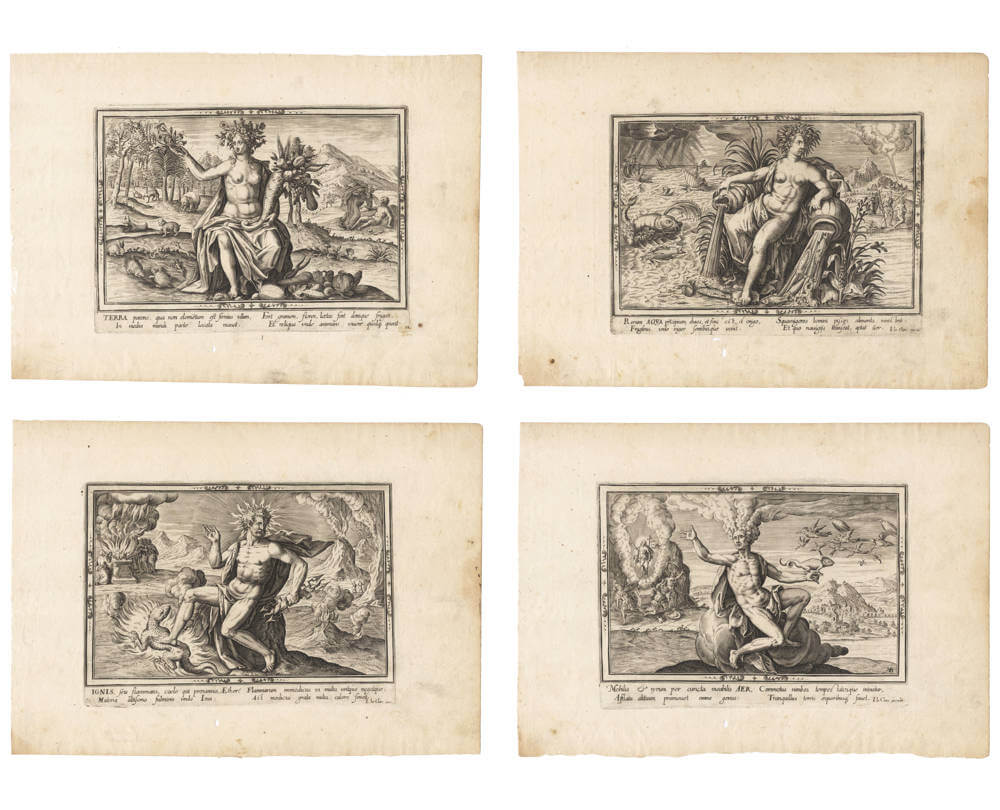Leen Helmink Antique Maps & Atlases
www.helmink.com
Collaert
TERRA - AQVA - IGNIS - AER
Certificate of Authentication and Description
This is to certify that the item illustrated and described below is a genuine antique
map, print or book that was first produced and published in 1600, today 425 years ago.
December 15, 2025
Cartographer(s)
Collaert
First Published
Antwerp, 1600
This edition
Paris, ca 1602
Size
13.3 x 18.0 cms
Technique
Copper engraving
Stock number
19297
Condition
excellent


Description
Famous set of engravings of the elements by Adriaen Collaert, after paintings by Maerten de Vos, here in unrecorded version by Jean LeClerc.
Engravings. Measurements: mm 132/134x180. Sheet: mm 192/195x273/275.
New Hollstein (The Collaert Dynasty), 1282-1285 (copies).
Complete and uniform series translated in counterpart and in rectangle from the analogous collection in an oval engraved by Adriaen Collaert. On the plate representing the Air, in the lower right corner, the monogram "AB" appears; in the margin at the end of the Latin verses, the "excudit" by Jean le Clerc is present on three out of the four engravings.
Arguably the best and definitely the rarest set of allegories of the four classical elements.
Condition
Beautiful proofs finely and clearly inked, printed with tonality on thin, unwatermarked, creamy paper.
Complete sheets with original margins, slightly browned at the edges. On all plates, there is a trace of worming at the bottom margin. Slight signs of use.
Poems on the elements
The Latin verses at the bottom of each print transcribe and translate as follows:
TERRA parens, qua non elemétum eft firmius vllum, In media mundi parte mundi parte locata manet.
Fert gramen, flores, laetas fert denique fruges, Et reliqua vnde animans vivere quoda queat.
Mother EARTH, in which there is no element firmer, remains located in the middle part of the world.
She bears grass, flowers, and finally, she bears joyful fruits, and everything from which a living being can sustain life.
Rerum AQVA pricipium, chaos, et fons est, et origo, Frugibus unde vigor Semibusque venit.
Squamigeros homini pifces alimenta ministrat Et quo nauigi's tranfeat, aptat iter.
WATER is the beginning of all things, chaos, and source, from which vigor comes to fruits and seeds.
It provides scaly fish as sustenance for humanity and prepares the path for ships to traverse.
IGNIS, feu flammans, coelo qui proximus, Ether; Materia altifono fulminis vnde Ioui:
Flammarum immodicus vi multa vritque negatque, Ast modicus grato multa calore fouet.
FIRE, or the blazing element, which is closest to the sky, the substance from which the lofty thunderbolt of Jupiter originates:
It both burns excessively with the force of flames and provides much warmth in moderation with pleasing heat.
Mobilis et rerum per cuncta meabilis AER, Afflatu alituum promouet omne genus:
Commotus nimbos tempestates que minatur, Tranquillus terris æquoribusq fauet.
The mobile and permeable movable AIR, nourishing every kind through the breath of winds,
When stirred, threatens with clouds and storms, while when calm, it favors the lands and seas.
Aristotle's quartet: the classical elements in antiquity
The classical elements refer to earth, water, air, fire, and (later) aether which were proposed to explain the nature and complexity of all matter in terms of simpler substances.
The ancient Greek concept of four basic elements, these being earth (γῆ gê), water (ὕδωρ hýdōr), air (ἀήρ aḗr), and fire (πῦρ pŷr), dates from pre-Socratic times and persisted throughout the Middle Ages and into the Early modern period, deeply influencing European thought and culture.
In On the Heavens (350 BC), Aristotle defines "element" in general:
An element, we take it, is a body into which other bodies may be analysed, present in them potentially or in actuality (which of these, is still disputable), and not itself divisible into bodies different in form. That, or something like it, is what all men in every case mean by element.
— Aristotle, On the Heavens, Book III, Chapter III
In his On Generation and Corruption, Aristotle related each of the four elements to two of the four sensible qualities:
Fire is both hot and dry.
Air is both hot and wet (for air is like vapor, ἀτμὶς).
Water is both cold and wet.
Earth is both cold and dry.
(Wikipedia)